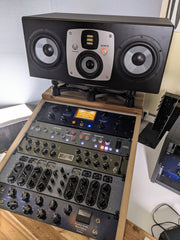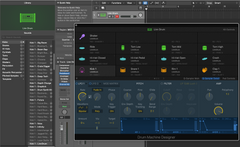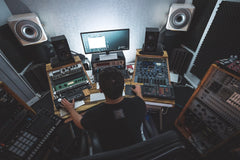Beginner's Guide to Experimental Techno Music by Alicia Clark
While this album didn’t enjoy much commercial success at the time of release, today, it’s widely recognised as a genre-defining compilation – one that techno artists always come back to in order to trace the roots and original intent of the EDM-born genre. Since the late ‘80s, techno has been debated, remixed, rehashed, and respun in every way imaginable, resulting in the various experimental techno sub-genres we have now.
In the world of analog acid techno, Trickfinger is the man to see. Also known as legendary funk guitarist John Frusciante of the Red Hot Chili Peppers, Trickfinger’s work combines fingerstyle acoustic guitar, classic European techno, and complex melodies. But make no mistake about it; stylistically speaking, Trickfinger is very much in touch with the genre’s roots. In this feature on Vice, he explained why he first experimented with analog acid house. "A lot of my heroes in electronic music, like Aphex Twin and Squarepusher—that was their starting point, so I figured if I'm going to spend the rest of my life being a composer in the modern sense, then I needed to learn how to start doing that."
Similar to Trickfinger’s sound, another artist to watch for is Forest Drive West, whose raw and emotive blend of acid techno/house introduces post-rock sensibilities to EDM. Meanwhile, Minor Science leans closer to classic ‘80s Detroit dance music, with their upbeat melodies, echoing vocal samples, and synthwave vibe. Additionally, harder, weirder industrial techno enthusiasts will want to hear the works of Simo Cell, Bergsonist, and Roza Terenzi, whose aggressive takes on the ‘sound of the future’ conjure visions of futuristic car chases and laser cannon fights. From raw club dance mixes to introspective, meditative melodies, the inherently avant-garde nature of techno has over the decades developed into a full-blown genre, complete with its own stories, clashing styles, and visions for the future.
If you’re looking to experiment and create your own blend of contemporary techno, the most fun and intuitive way to do it is with a physical modular synthesizer. Creating ‘experimental music’ with a synth is both the easiest and most difficult thing to do. This is because the path of modular synthesis breaks analog music down to its most essential elements, which means universal control for making literally any sound or sequence you want. For those new to modular synthesis, even the simplest functions like increasing the rise and fall rate of a wave to turn the clicking of control voltage into a pitch is arguably experimental. Even just connecting the wrong patches or turning the wrong knobs can result in the happiest, most harmonic accidents.
This is why techno is such a rich genre, whether you’re more into classic minimalist ‘80s techno or its more contemporary and experimental evolutionary cousins. Much like the electric guitar after Hendrix, almost everything’s been done with the synthesizer to create what can be considered ‘experimental techno.’ This isn’t to say that the task is impossible – just that it’s hard. It’s easy to start experimenting, but as electronic music itself progresses, it becomes increasingly difficult to arrive at truly original unorthodox compositions.
Subscribe to the Riemann Kollektion Youtube channel!
In short, to start working on experimental techno, you should at least have a keen understanding of modular synthesis. From there, you can start working with some inherently experimental modules that can quicken your exploration. Sapel’s random voltage generator module for instance allows you to apply random control voltages onto any other module on your synth rack. This can be used to apply strange delays and decays to any regular beat, or to randomise pitch sequencing for truly alien sounds. If your goal for experimenting with techno is to create truly unpredictable beats, random modules are your friend.
Some synthesizer units are also more suitable for experimentation than others. Moog’s new Subharmonicon for instance can give you direct control over producing and sequencing subharmonics, which are the unnatural undertones opposite the overtones of traditional harmonics. The field of subharmonics is rarely explored in contemporary music, which makes the sounds generated more inherently experimental. On top of that, the Subharmonicon also affords users control over three different octave ranges. This can allow you to extend or limit the octave ranges of particular patches or sequences on the fly, which is basically an easy way to ‘remix’ a single sequence into a new melody or arrive at different complex chords.
FREE Sample pack: 542 Techno Loops & Oneshots
Download in here: Free Sample Packs
Whether you’re using new instruments like the Subharmonicon, a more classic Moog synth, or a custom Frap or Eurorack rig, there are really no rules to how you can experiment and patch modules. You can combine Frap Sapel’s randomiser with the Subharmonicon’s polyrhythmic oscillators to create strange and fresh beats instantly. Meanwhile, meticulously experimenting with the slewing module on a basic Eurorack rig can allow you to simulate guitar string sounds, and from there you can patch specific modules or your entire output to actual reverb or distortion guitar effects pedals. Of course, none of these methods can guarantee that you’ll create good and original music. As with any composition, you need to play it by ear. When it comes to producing what can be considered experimental in the world of techno, analog modular synthesis is a truly improvisational process.
If you’re more comfortable working on your laptop or computer, you can also use any DAW or music creation software that you prefer. Bengal and its semi-modular polyphonic synth simulation would be a good choice for beginners. Meanwhile, the more complicated and experimental Granulated II has some unique and must-hear signal modulation capabilities. Even just your basic version of Ableton Live can go a long way. You can read more about these and other DAW in our list of software for techno producers, which is technically everything you need to experiment with techno. While some might argue that using a DAW is less intuitive than analog modular syntesizers, it’s also arguably easier to come up with new module configurations when you’re working with a digital rig. Besides, if you already have a mid-range laptop, using a DAW is infinitely cheaper than analog.
Another way to explore unorthodox techno territory is the inclusion of vocals. If you want a vocal component to your music without sampling existing tracks, you’ll also need a vocal mic. In this article by Shout4Music, the site notes that although vocal microphones tend to come with some signal colouration, they’re also some of the most versatile mics available. The Shure SM58 for instance is a durable ‘industry standard’ mic for either live shows or studio work. This makes it useful not just for capturing vocals, but also percussive and acoustic instruments, or even sampling real world sounds. If you have minimal plans of working outside the studio, you might fare better with the Neumann TLM 102, which is on the more affordable end of top studio mics. Either way, having a real microphone in your arsenal will make it easier to experiment towards ambient, acid, analog, or industrial techno territories.
However you want to experiment with new techno, always remember to listen to the Detroit classics, pay homage to the contemporary geniuses, and maximise whatever is in your arsenal. While it may not be an easy task, it’s definitely a worthwhile undertaking for any musician who wants to evolve. It’s your turn to shape the ‘sound of the future.’
Follow us on Instagram 
If you like this article, please share it in your favorite producer group on Facebook or any other social media, thanks!
Written by Alicia Clark last update 24. October 2020. Version 1.0



